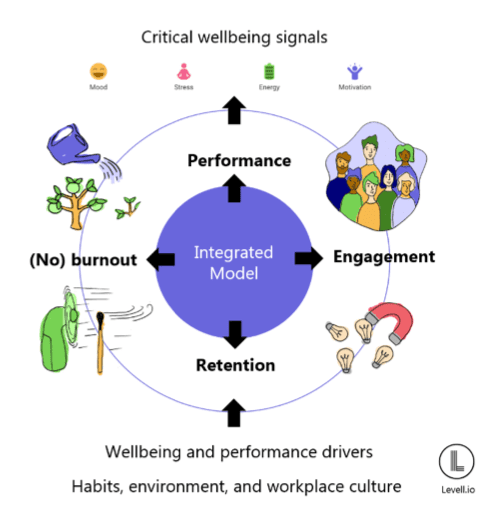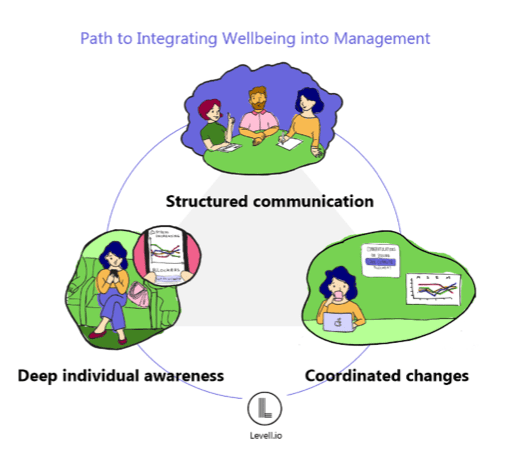Lessons from burnout: why wellbeing is the next frontier of workforce management

We’re delighted to feature this guest post by Madeleine Evans, who will be speaking at Workplace Trends: Towards a New Era of Work and Workplace, in London on 15 October 2019. For details on her presentation, “Mental health and productivity in work culture”, fellow speakers, attendees, and how to register, visit the conference page here.
The bad news – 340 million workers are still struggling to get their basic needs met
Exhaustion, burnout, chronic stress, frustration, and dis-engagement impact 60% of workers, differentially women, those in high-pressure services jobs, and in high-demand low-resource industries. According to data collected from Levell’s proprietary survey of 2,000 UK and European workers together with Streetbees, as well as insights from the Yale Center for Emotional Intelligence’s Emotion Revolution in the Workplace dataset – these mental and emotional health barriers are significantly correlated with lower life satisfaction, lower job satisfaction, and greater intention to leave.
The good news – companies are starting to become aware of, and act on, the impact of poor mental health on productivity and performance in the workplace
In an interview for MadWorld, Dr Shaun Davis, global director of safety, health, wellbeing and sustainability, Royal Mail Group, explained the importance of culture and conversation – and internal forums – in creating a healthy and sustainable population. Another leader to mention is Andy Croxford, in the government’s Environment Agency, who facilitated a shift in social norms and expectations around mental health by creating space for employees to build an inter-departmental network that enabled greater peer-to-peer support.
Individual conversations about mental health in the workplace, and strategies to break the taboos around mental health issues, are gaining traction. Employees are beginning to get the psychological and physical opportunity to exchange information about their wellbeing, mental and emotional health, and life satisfaction alongside or in tandem to conversations about work performance. This is a fantastic shift.
Over the next five years, the leading companies will go further. Frontier companies will build on the opportunities afforded by today’s movement for greater mental health awareness, combined with a refreshed attention to diversity and inclusiveness, to make comprehensive workforce organisation, work environment, and process changes.
These changes are – and will be – triggered by a new level emotional honesty and self-reflection by C-level leaders and reinforced by the increasingly obvious desire of employees (particularly Millennial women) to have more inclusive, psychologically satisfying, and emotionally rich experiences at work.
These are the questions that will be asked in the C-suite:
- How do we systematize these conversations around wellbeing, and efficiently gather data on the common drivers, and blockers, to human mental, emotional, and physical health in the workplace?
- Once we have that data, how do we link that data to engagement, retention, and work performance?
- How do we – as CIOs, CFOs, CHROs – apply those insights to make prioritised changes to company policies and work processes?
- How do we do that in a manner that is low-cost and empowering to employees?
In response, this is the question that will be asked by mission-driven technologists, wellbeing and mental health activists, and social innovators:
- How do we help people at all levels of a company work together to do what is right for the long-term health and performance of the organisation and the individuals in their workforce?
- How do we provide new tools for optimising for both company performance and human wellbeing?
This is the question I set out to answer, together with Dr. Julia Moeller, specialist in emotion and motivation in the workplace, Yale affiliate and our lead Research Adviser at Levell.
Research gives us statistics on incidence, as well as frameworks for finding a solution. At Levell, we’ve done a comprehensive review of academic literature to create an integrated model of the links between engagement, performance, retention, and burnout, and overlaid this with the framework proposed by the Mayo Clinic – developed after 20 years of research – for defining and operationalising organisational wellbeing.
Here are the components.

At the first level, we look for four critical feelings, which we call wellbeing signals – mood, stress, energy, motivation – that link to key components of engagement, performance, burnout, and mental and emotional health.
Why are these signals important?
We all know stress is fundamentally linked to performance (see the Lazarus & Folkman model). Stress also links to creativity (we like this meta-analysis), which impacts strategic and innovative performance over the long term. Energy is required for delivering on work product, but it is also a primary sub-component of engagement, as made clear by the widely-accepted component model of engagement (vigour, dedication and absorption) in academic literature today. The state of being motivated is effectively the state of engagement – but is differentiated in practice by a sense of drive and desire rather than just the capacity to act. Mood – let’s call it positive or negative valence, as well as arousal – can be a signal of emotional energy as well as satisfaction or frustration with work.
Beneath these signals lie wellbeing and performance drivers, which can be split into four factors.
At the heart, is the balance of demands vs. resources that individual experience on a daily basis, along with their values and motivational alignment to their situation at work. Over time, the balance of demands and resources should be viewed from the lens of stress vs. recovery, and person-work alignment needs to be evaluated to see if it is translating into meeting individual needs.
Beneath this lie, individual habits, their work and life environment, and workplace culture.
These factors influence the presence or perception of demands vs. resources, and the likelihood of alignment of a person’s values and motivations with their situation at work.
Given the nature of these interlinkages, the next obvious solution is to integrate wellbeing directly into the management process and make it a cornerstone of workplace culture.
Companies can apply these insights from occupational and applied psychology, and the science of stress and performance, in a strategic roadmap for making integrated changes.

Here are the steps.
1. Deep individual awareness.
Frontier companies will help their leaders, and all their employees, accelerate the process of self-awareness through a consistent and structured process of self-observation and self-reflection on wellbeing and performance drivers, as well as blockers or enabling factors from habits or culture.
2. Structured communication.
To optimise joint performance, companies will need to consistently gather about how where and when their employees are struggling with their wellbeing or facing blockers. To overcome the trust barrier, companies need a bottom-up “need to know” process that enables individuals to share data on personal status (relevant to performance), alongside information on common blockers or ideas for improvement, up to leaders in the company or their teams.
3. Coordinated changes.
Exhaustion, frustration, and burnout – and on the flip side, wellbeing – are driven by factors that are individual-specific, company-specific, and/or a result of an interaction between the individual and their environment. To address this problem, frontier companies will empower their employees with clear sets of expectations, as well as latitude, to innovate in both individual behaviour as well as collective work process. This means supporting individual habit-building, team-based innovation, and coordinated multi-department structural change.
In conclusion
Over the next five years, new companies will emerge that go way beyond wellbeing perks, and breaking mental health barriers, to position wellbeing as the frontier, and core, of workforce management.
These frontier companies will directly integrate people management processes with processes for managing wellbeing and mental health at the level of the company, team and individual.
To get there, these companies’ leaders will make strong statements about creating work great workplace cultures – which require human wellbeing alongside performance, provide a common definition of wellbeing and performance drivers, and set the tone and expectations for the quality and quantity of innovation through self-reflection, communication, and experimentation at all levels.
This means empowering their employees to work together, to build a much deeper level of individual and interpersonal awareness, share work-relevant information about their wellbeing through a structured and secure platform for communications, and utilising collective inputs and advanced data analysis to identify prioritised culture changes – designed to optimise for both company performance and human wellbeing.
In one of my early conversations I spoke to Geoff McDonald, ex-global VP and HR lead at Unilever, who made Unilever one of the most sought-after places to work over his tenure of 10+ years. His words sum it up nicely.
“Most organisations are paying lip service to wellbeing at the moment, with bananas in the staff room and so forth… What is needed is to directly integrate, as you say, wellbeing into the management process, as a systems intervention. That is really the solution and the frontier.”
Our takeaway
If you’re at the frontier, keep going. If you’re not there yet, hop on board.

Guest post by Madeleine Evans, who will be speaking at Workplace Trends: Towards a New Era of Work and Workplace, in London on 15 October 2019. For details on her presentation, “Mental health and productivity in work culture”, fellow speakers, attendees, and how to register, visit the conference page here.
Madeleine is an ex-investor and social activist with varied experience across mature, high-growth and transforming companies. She is also the founder/CEO of the management technology company, Levell. Levell helps people and companies integrate wellbeing into work culture, improving personal productivity, team performance, and company results.
First published at Mad World Summit
